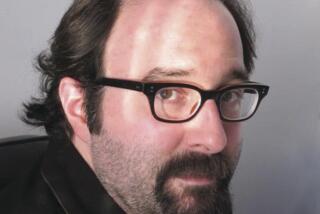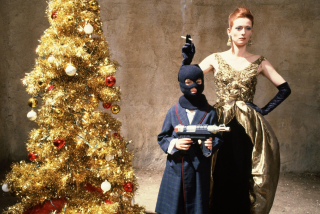When films cast a come-hither look
- Share via
WHAT would you rather have -- morality or money? In Hollywood, at least in the desperate years between 1930 and 1933, the answer came wrapped in a string of sexually provocative and graphically violent films aimed at viewers for whom “Skippy” and the Marx Brothers weren’t enough reason to lay down precious pennies for a ticket.
“The studio people were hit by the haymaker by the Depression,” says Rick Jewell, a professor at USC’s School of Cinema and Television. “Their audience disappeared overnight -- not all of them, but a huge percentage. They figured that if we don’t give people something that is really titillating, something they haven’t seen on the screen, they are not going to pay money to go to the theater.”
So along with films such as the action-adventure classic “King Kong” and high-tone literary adaptations like “Little Women,” there were racy offerings such as 1933’s “Baby Face,” in which Barbara Stanwyck plays the ruthless daughter of a steel-town speak-easy owner who serves up sexual favors along with beer at her father’s sleazy establishment, then moves to New York, where she sleeps her away to the top of the corporate world -- and finds true love.
“Baby Face” and two more risque classics -- 1931’s “Waterloo Bridge” and 1932’s “Red Headed Woman” -- are featured in Warner Home Video’s “TCM Archives: Forbidden Hollywood Collection, Vol. 1,” which will be released Dec. 5. The previous evening, Turner Classic Movies will air the three titles along with three other examples of the genre.
These films, before the Motion Picture Production Code, a.k.a. the Hays Code, was put into effect in mid-1934, are known as pre-code movies. And they thrived, despite the existence of content guidelines written by a priest in 1930, because of political double-dealing at the studios.
An office called the Studio Relations Committee, says Jewell, looked at films and decided whether they were acceptable to be released. But there was a loophole in the appeals process: If a film had been rejected by the committee, it could be reviewed by three executives from other studios. “They could overturn the decision and, in almost all cases, they did because they figured they wanted to get the same treatment.”
Though some pre-code films seem tame by today’s standards, there is still a lot to shock. In the three “Forbidden Hollywood” films, there is no question that the women are sleeping around. In the opening sequence in “Red Headed Woman,” Jean Harlow is trying on a skirt and asks the saleslady if she can see through it. When the clerk says yes, Harlow squeals and buys the skirt.
Actresses in these films were seen in various states of undress -- Harlow, for example, notoriously wouldn’t wear underwear and flounced her breasts as she chased down men in “Red Headed Woman.” Mae Clarke wears a see-through bra in one scene in “Waterloo Bridge.”
But that’s not to say the performances themselves are underdressed. Clarke, the actress best known for having Jimmy Cagney shove a grapefruit in her face in “The Public Enemy,” shines in “Waterloo Bridge,” the first film James Whale (“Frankenstein”) directed for Universal. The film, which has been out of circulation for 75 years, also marks the debut of Bette Davis.
Harlow is at her sultry, sassy best in “Red Headed Woman,” penned by Anita Loos of “Gentlemen Prefer Blondes” fame. Harlow plays an ambitious secretary who wants to climb the social ladder one rich man at a time. And Stanwyck is a standout in “Baby Face.”
“I think that at the time none of those ladies were really given the credit they deserved,” says TCM host and film historian Robert Osborne. “We hadn’t seen their whole body of work. When you look back and see a ‘Baby Face’ as part of the Stanwyck portfolio, as it were, it is such an incredible career and that she was so good so early.”
The collection features both the release version of “Baby Face” and the uncut original, which was recently found in the Library of Congress.
Though these pre-code films were often box office hits, certain states banned them or would release only edited versions. Women’s groups and the Catholic Church became very vocal in its opposition to the risque fare. And ultimately, the same sort of box office concerns that had led to the rise of the films led to their downfall.
In 1933, the Catholic Church formed the Legion of Decency -- Catholics took an oath that they would not see films condemned by the group. “That was kind of the last straw,” says Jewell. “The studio heads could not stand up to that level of organized pressure.”
So in 1934, the Breen Office, a special bureau named after public relations executive Joseph Ignatius Breen, was formed. The sole purpose of the office was to review scripts and prints to make sure they were not immoral.
Pre-code movies were taken out of circulation. And remakes of pre-code movies were often not permitted. MGM made “Anna Christie,” based on Eugene O’Neill’s play about a prostitute in 1930. The hit marked Greta Garbo’s first talkie. But the Breen Office wouldn’t allow MGM to remake the movie because even insinuating her profession was not allowed. “If there hadn’t been an ‘Anna Christie,’ what would have happened to Garbo’s career?” says film historian Cari Beauchamps.
The performer hurt the most by the production code was Mae West, whose 1933 hits “She Done Him Wrong” and “I’m No Angel” were filled with sexual innuendo. “When they clamped down on sex there wasn’t anything for her to do [in films] anymore,” says Jewell.
And with the introduction of the Breen Office, Hollywood went from “Baby Face” to “Baby Take a Bow,” as 6-year-old Shirley Temple became the hottest commodity in Hollywood.
More to Read
Only good movies
Get the Indie Focus newsletter, Mark Olsen's weekly guide to the world of cinema.
You may occasionally receive promotional content from the Los Angeles Times.











